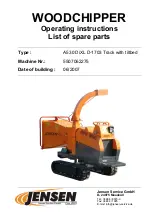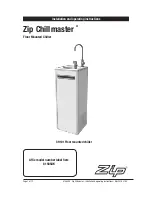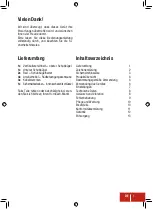
4
the unit. Do not place the pinch valve before the exchanger or it may not remain full of wort.
For pump chilling:
This procedure is used for systems where a pump is utilized to
move the wort from the boil kettle to the fermentor. Install the
exchanger as shown in the diagram below ensuring that the
exchanger is laid on its side and is lower than the brew pot
and at the same level as the bottom of the fermentor (or below
it). If it is raised higher, the wort will drain from the
exchanger exposing a portion of the plates and lower the
capacity of the unit. Place the exchanger
after
the pump to
reduce the possibility of pump cavitation. It is also advisable
to have the pump and valve on the hot side of the exchanger
(pumping hot wort) to reduce the possibility of bacterial contamination.
ThruMometer (057.152.1):
We highly recommend using the ThruMometer in-line thermometer
from Blichmann Engineering (shown in Fig. 6) to properly set the
exchanger to the ideal outlet temp (20°C or 68
o
F) and cooling water
flow rate as described in the procedure below. The low cost, high
precision, fast response, and mirror smooth interior (easy to sanitize),
make it far superior to any in-line thermometer on the market. Go to
www.BlichmannEngineering.com for details.
Setting flow rates:
Warning:
Ensure all hoses are properly secured as described above.
Surfaces of the exchanger, fittings and hoses may be hot during use.
Before pumping or draining hot wort through your heat exchanger, turn the cooling water on to the
maximum flow rate, which will purge all air from the water side of the exchanger. Slowly increase the hot
wort flow rate until you reach the desired outlet temperature. If using the ThruMometer
TM
in-line
thermometer and you never see a change in color on the thermometer elements, carefully touch the side of
the ThruMometer
TM
and determine if the temperature is above 88
o
F or below 58
o
F (above 31°C or below
14°C). If above 31°C (88
o
F), slow down the beer flow rate. If below 14°C (58
o
F), increase the wort flow
rate. If it is still too cold, slow down the water flow rate, leaving the wort flow rate at maximum.
Notes for Southern Climates:
Brewers in southern climates have a particular challenge chilling wort due to the elevated ground water
temperature. Cooling water temperatures can exceed 80
o
F in the summer, making chilling wort to the
ideal temperature (20°C or 68
o
F) impossible. However, the incredible cooling capacity and efficiency of the
Therminator
TM
chiller will allow the wort to be chilled much closer to the ground water temp, at a faster
rate, and using less water than any chiller on the market. Obviously, wort flow rate and wort outlet
temperature are trade-offs. A good rule of thumb (assuming 5gpm of water flow) is that the Therminator
TM
will chill about 3-5
o
F above the cooling water temperature at moderate wort flow rates (about ¾-1gpm),
and about 10
o
F above the cooling water temperature at higher wort flow rates (about 1.5-2 gpm). Heat
exchanger performance is not linear, so it is difficult to predict exact performance at conditions not shown
in the graph below. Bear in mind that the performance graph is based on cooling the wort to 20°C (68
o
F).
Fig. 6
Fig. 5

























